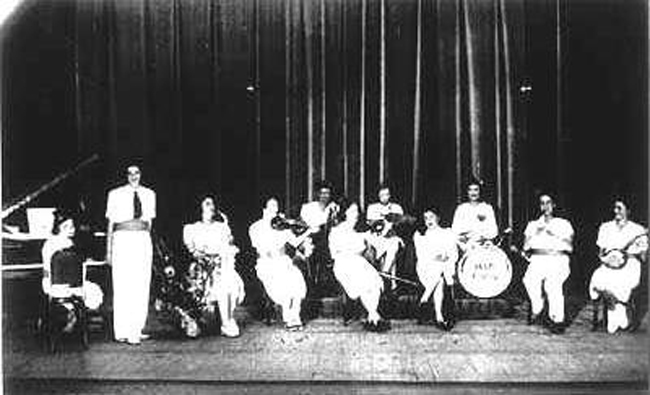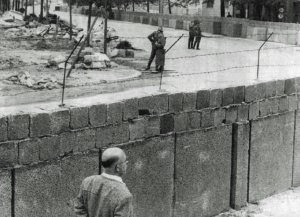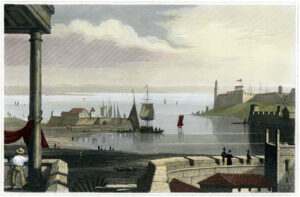by Anne Sebba
The Women’s Orchestra of Auschwitz author Anne Sebba shares with The History Reader the horrifying story of the 45 women forced to play music in an Auschwitz concentration camp orchestra.

The idea that a death camp devoted to killing people in as ruthless and bestial a manner as possible could also be a place where music, the most sublime of all the arts, was encouraged and even loved is impossible for many people to comprehend. Yet, for almost two years at the height of World War II, a ‘Girls’ Band’ provided a lifeline enabling approximately 45 young women to survive. Fortunately, two of those women were still alive and able to be interviewed while I was researching my book. They were able to tell me firsthand what it was like to feel freezing cold, hungry, and fearful; yet nonetheless, have to perform twice daily to please their Nazi bosses. Such an impossible story almost needs a living witness as proof that it happened. While the Nazis were trying to eradicate Jews and obliterate Jewish culture, in this instance, they were preserving a small group of them, even giving some of them lessons to ensure the quality of the orchestra.
I asked one of those musicians if she could explain to me how they survived. “We could not think of the future. We just hoped to survive until the next day,” the then 99-year-old cellist Anita Lasker explained in one of my interviews.
As the last survivor, Anita, now 100, has been asked to give many interviews on behalf of all the rest. She does this so regularly that she commented, “I came to the conclusion that it’s better somebody survives to tell the story. I don’t feel too guilty about that.”
On the day of her 100th birthday in July 2025, King Charles came to visit her at home in North London to hand-deliver a birthday card.
Lasker-Wallfisch was such a valuable member of the girls’ marching band, the name they themselves gave their group, because until she joined, there were no bass instruments. Instead, a motley collection of recorders, piccolos, mandolins, violins, an accordion, a guitar, and a percussionist made up the band.
At its height, the Vienna-born conductor Alma Rosé, niece of Gustav Mahler and a virtuoso violinist in her own right, managed to train more than 43 women and young girls to play together, in time and in tune, so that they were saved from being deliberately killed in the gas chambers of Auschwitz-Birkenau. Almost all survived the camp, although two died from disease and malnutrition after they had been forcibly moved to the camp at Bergen-Belsen in early 1945 as the war was ending and the Russians were approaching Auschwitz. Alma herself had died of food poisoning, possibly the deliberate result of someone being jealous of her so-called privileges.
The Nazis had ordered the creation of the band so that the other women prisoners, who had to undertake forced labour in nearby factories or demolition squads, would march faster, making it easier for them to be counted in rows of five. It was the only all-female orchestra in any of the camps, prisons, and ghettoes run by the Nazis. It was comprised of women from eleven nations and a wide span of ages (from 15-55) as well as a wide range of political and religious beliefs. Although they had arguments among themselves, mostly about food or lack of it, when they needed to perform, they showed a remarkable degree of sisterhood, tuning each other’s instruments or teaching others the tune. If they did not play well, they would, as their conductor frequently reminded them pointing to the smoke, all go to the gas.
One of the themes in my book about the orchestra, published to mark the 80-year anniversary of the liberation of the camps, is to examine how these women found the inner strength to help them survive when all around they were surrounded by intense suffering and brutality. Many of them had arrived in Auschwitz after seeing their parents, friends, or siblings pulled into the line of those who were immediately gassed. Others had already been in prison for resisting or being Jewish, often tortured, before they were given a place in the music block. Some women were driven to survive by a desire for post-war revenge on those who had betrayed them, others by a desperate need to bear witness to what they had seen. But most, simply wanted to live and taste a better life.
Anita Lasker-Wallfisch, although she always insists that survival was “a matter of luck,” admits that being a cellist instead of simply a tattooed number, crucially restored an element of humanity. She also maintains that the music, ghastly jaunty popular tunes, was not what saved them, except to the extent that it gave them all something to concentrate on other than the brutality and killing.
When I started my research, I believed, according to various published accounts and from Anita herself, that she was the only remaining survivor of the orchestra. However, by an unlikely series of events, I discovered another survivor, Hilde Grünbaum, at that point also 99 and living on a kibbutz in Israel. I immediately went to visit her and the interview I had with her, in spite of her frailty, was crucial in helping me understand this triumph of the human will to survive in the direst of circumstances. Hilde Grünbaum, a passionate Zionist, unlike her friend Anita, had such a strong moral certainty that she would survive and live to see better times that she declined a place on the Kindertransport to come to England in order to stay with her mother, who was subsequently killed.
Hilde also became the unofficial leader of the group when the women were transferred to Belsen, ensuring that everyone had a fair share of the meagre soup and bread rations and encouraging the women to never give up hope. When asked years later what drove her in such appalling circumstances, she said, “I knew that if I didn’t do my best to help people, then there would be nothing left.” Meeting Hilde helped me understand the real privileges of the musicians’ block. Not so much a pair of underpants or access to a toilet, important though these were, but the ability to hope, which in Hilde’s case meant hoping to build a better life in a new country where Jews would not face anti-Semitism. Hilde never lacked courage, and just as the Jewish musicians were being forced onto the train for Belsen, she bravely dashed back into the music block to rescue three crucial artifacts: Alma’s diary and the red hand-sewn music bag, as she knew the world would never believe what they had been forced to do to survive. These objects, now in Yad Vashem, are an important part of any historian’s research into the orchestra.
While I have a proper reverence for archives and documents, there were no diaries kept in Auschwitz, nor access to pencil or paper on a regular basis. The orchestra had to write out the different parts on plain paper from the office, so primary sources mostly comprise accounts written later. I believe there is something vitally important about interviewing those who actually witnessed the events. I have tried to create a synthesis of all the sources available to me in my search to understand if these were simply ordinary women who transcended their circumstances (because they never gave up hope in a better future) or extraordinary women. I can never know, but I think that sisterhood, small acts of kindness, and solidarity of the group played a part in strengthening the basic, ordinary will to survive and that which identifies us as human.

ANNE SEBBA is a prize-winning biographer, lecturer, and former Reuters foreign correspondent who has written several books, including That Woman and Les Parisiennes. A former chair of Britain’s Society of Authors and now on the Council, Anne is also a Senior Research Fellow at the Institute of Historical Research. She lives in London.
The post The Band Played on at Auschwitz appeared first on The History Reader.




0 Comments